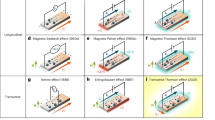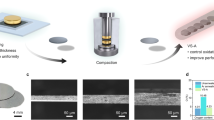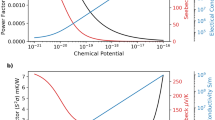Abstract
In the 1850s, Lord Kelvin predicted the existence of a thermoelectric cooling effect inside a whole material (the Thomson effect) according to thermodynamics1, in addition to the Peltier effect that enables cooling at the junction between dissimilar materials. However, the Thomson effect is usually negligible (ΔT/T < 2%) in conventional thermoelectric materials because the entropy change in charge carriers is fairly small2, leading to the guiding principles for advancing thermoelectric cooling to be based on the framework of the Peltier effect and that the figure of merit ZT should be maximized to optimize performance. Here, we demonstrate a Thomson-effect-enhanced thermoelectric cooler using a large Thomson coefficient (τ) induced by the direct manipulation of charge entropy through an electronic phase transition in YbInCu4. The devices achieve a steady temperature span (ΔT) of >5 K from T = 38 K. Our findings suggest not only another approach to advance thermoelectric coolers in addition to improving ZT but also technologically opens opportunities for solid-state cryogenic cooling applications.
This is a preview of subscription content, access via your institution
Access options
Access Nature and 54 other Nature Portfolio journals
Get Nature+, our best-value online-access subscription
27,99 € / 30 days
cancel any time
Subscribe to this journal
Receive 12 print issues and online access
269,00 € per year
only 22,42 € per issue
Buy this article
- Purchase on SpringerLink
- Instant access to full article PDF
Prices may be subject to local taxes which are calculated during checkout




Similar content being viewed by others
Data availability
Data supporting the findings of this study are included in this letter and its Supplementary Information or available from the corresponding authors on request. Source data are provided with this paper.
References
Thomson, W. 4. On a mechanical theory of thermo-electric currents. Proc. R. Soc. Edinb. 3, 91–98 (1851).
Lee, H. The Thomson effect and the ideal equation on thermoelectric coolers. Energy 56, 61–69 (2013).
He, J. & Tritt, T. M. Advances in thermoelectric materials research: looking back and moving forward. Science 357, eaak9997 (2017).
Han, C. G. et al. Giant thermopower of ionic gelatin near room temperature. Science 368, 1091–1098 (2020).
Sakai, A. et al. Iron-based binary ferromagnets for transverse thermoelectric conversion. Nature 581, 53–57 (2020).
Hinterleitner, B. et al. Thermoelectric performance of a metastable thin-film Heusler alloy. Nature 576, 85–90 (2019).
Zhang, Q., Deng, K., Wilkens, L., Reith, H. & Nielsch, K. Micro-thermoelectric devices. Nat. Electron. 5, 333–347 (2022).
Rockwood, A. L. Relationship of thermoelectricity to electronic entropy. Phys. Rev. A 30, 2843–2844 (1984).
Goldsmid, H. J. Introduction to Thermoelectricity (Springer, 2009).
Mao, J., Chen, G. & Ren, Z. Thermoelectric cooling materials. Nat. Mater. 20, 454–461 (2021).
Snyder, G. J., Toberer, E. S., Khanna, R. & Seifert, W. Improved thermoelectric cooling based on the Thomson effect. Phys. Rev. B 86, 045202–045209 (2012).
Zebarjadi, M. & Akbari, O. A model for material metrics in thermoelectric Thomson coolers. Entropy 25, 1540–1550 (2023).
Ouerdane, H., Varlamov, A. A., Kavokin, A. V., Goupil, C. & Vining, C. B. Enhanced thermoelectric coupling near electronic phase transition: the role of fluctuation Cooper pairs. Phys. Rev. B 91, 100501–100505 (2015).
Sun, P., Ikeno, T., Mizushima, T. & Isikawa, Y. Simultaneously optimizing the interdependent thermoelectric parameters in Ce(Ni1−xCux)2Al3. Phys. Rev. B 80, 193105–193108 (2009).
Mao, J. et al. High thermoelectric cooling performance of n-type Mg3Bi2-based materials. Science 365, 495–498 (2019).
Chung, D. et al. CsBi4Te6: a high-performance thermoelectric material for low-temperature applications. Science 287, 1024–1027 (2000).
Ishiwata, S. et al. Extremely high electron mobility in a phonon-glass semimetal. Nat. Mater. 12, 512–517 (2013).
Rowe, D. M., Kuznetsov, V. L., Kuznetsova, L. A. & Min, G. Electrical and thermal transport properties of intermediate-valence YbAl3. J. Phys. D: Appl. Phys. 35, 2183–2186 (2002).
Koirala, M. et al. Nanostructured YbAgCu4 for potentially cryogenic thermoelectric cooling. Nano Lett. 14, 5016–5020 (2014).
Kuo, Y. K., Sivakumar, K. M., Su, T. H. & Lue, C. S. Phase transitions in Lu2Ir3Si5: an experimental investigation by transport measurements. Phys. Rev. B 74, 045115–045119 (2006).
Akhanda, M. S. et al. Phase-transition-induced thermal hysteresis in type-II Weyl semimetals MoTe2 and Mo1−xWxTe2. Mater. Today Phys. 29, 100918–100924 (2022).
Modak, R. et al. Phase-transition-induced giant Thomson effect for thermoelectric cooling. Appl. Phys. Rev. 9, 011414–011422 (2022).
Nakagawa, K., Yokouchi, T. & Shiomi, Y. Reconfigurable single-material Peltier effect using magnetic-phase junctions. Sci. Rep. 11, 24216–24224 (2021).
Byeon, D. et al. Discovery of colossal Seebeck effect in metallic Cu2Se. Nat. Commun. 10, 72 (2019).
Brown, D. R. et al. Phase transition enhanced thermoelectric figure-of-merit in copper chalcogenides. APL Mater. 1, 052107–052116 (2013).
Liu, H. et al. Structure-transformation-induced abnormal thermoelectric properties in semiconductor copper selenide. Mater. Lett. 93, 121–124 (2013).
Mushnikov, N. V. Magnetic and magnetoelastic properties of valence transition compounds based on YbInCu4 (review article). Low Temp. Phys. 41, 946–964 (2015).
Jarrige, I. et al. Kondo interactions from band reconstruction in YbInCu4. Phys. Rev. Lett. 114, 126401–126405 (2015).
Anzai, H. et al. Abrupt change in hybridization gap at the valence transition of YbInCu4. Phys. Rev. Res. 2, 033408–033413 (2020).
Cornelius, A. L. et al. Experimental studies of the phase transition in YbIn1–xAgxCu4. Phys. Rev. B 56, 7993–8000 (1997).
Yang, Y. et al. Anomalous enhancement of the Nernst effect at the crossover between a Fermi liquid and a strange metal. Nat. Phys. 19, 379–385 (2023).
Chen, Z. et al. Leveraging bipolar effect to enhance transverse thermoelectricity in semimetal Mg2Pb for cryogenic heat pumping. Nat. Commun. 12, 3837 (2021).
Yang, R., Chen, G., Ravi, K. A., Snyder, G. J. & Fleurial, J. P. Transient cooling of thermoelectric coolers and its applications for microdevices. Energy Convers. Manag. 46, 1407–1421 (2005).
Snyder, G. J., Fleurial, J. P., Caillat, T., Yang, R. & Chen, G. Supercooling of Peltier cooler using a current pulse. J. Appl. Phys. 92, 1564–1569 (2002).
Fischbach, E., Löffert, A., Ritter, F. & Assmus, W. Thermoanalytical investigations to understand the dependence between the growth method and crystal properties of valence changing ‘YbInCu4’. Cryst. Res. Technol. 33, 267–274 (1998).
Löffert, A., Hautsch, S., Ritter, F. & Assmus, W. The phase diagram of YbInCu4. Phys. B 259, 134–135 (1999).
Levy, M. & Sarachik, M. P. Measurement of the Hall coefficient using van der Pauw method without magnetic field reversal. Rev. Sci. Instrum. 60, 1342–1344 (1989).
Acknowledgements
Z.C. and Y.P. express deep gratitude to the late J. He at Clemson University, South Carolina, USA, for constructive suggestions for this work. This work is supported by the National Natural Science Foundation of China (grant nos. T2125008 and 92163203 to Y.P., no. 92263108 to Z.C. and no. 52102292 to X.Z.), the Shanghai Rising-Star Program (grant no. 23QA1409300 to Z.C.) and the Innovation Program of Shanghai Municipal Education Commission (grant no. 2021-01-07-00-07-E00096 to Y.P.). We also thank J. Ma and H. Dong for their help on the susceptibility and X-ray diffraction measurements.
Author information
Authors and Affiliations
Contributions
Z.C. and Y.P. conceived the idea and designed the project. Z.C. and X.Z. grew the crystals and performed the structural/composition characterization. Z.C. and S.Z. performed the transport property measurements, prepared the cooling devices and carried out the measurements of cooling performance. Z.C., J.L. and Y.P. analysed the experimental and modelling data. All authors reviewed the results and drafted the paper.
Corresponding author
Ethics declarations
Competing interests
The authors declare no competing interests.
Peer review
Peer review information
Nature Materials thanks Jeffrey Snyder and the other, anonymous, reviewer(s) for their contribution to the peer review of this work.
Additional information
Publisher’s note Springer Nature remains neutral with regard to jurisdictional claims in published maps and institutional affiliations.
Supplementary information
Supplementary Information
Supplementary Sections 1–4, Table 1, Figs. 1–10, Discussion and References.
Source data
Source Data Fig. 1
Temperature-normalized Thomson coefficient data (Fig. 1c) and relative temperature span data (Fig. 1d).
Source Data Fig. 2
Inverse magnetic susceptibility data (Fig. 2a), characteristic coupling temperature data (Fig. 2b) and electronic band dispersion data (Fig. 2c).
Source Data Fig. 3
Transport property data (Fig. 3a–f).
Source Data Fig. 4
Temperature profile data (Fig. 4a) and temperature span data (Fig. 4b,c).
Rights and permissions
Springer Nature or its licensor (e.g. a society or other partner) holds exclusive rights to this article under a publishing agreement with the author(s) or other rightsholder(s); author self-archiving of the accepted manuscript version of this article is solely governed by the terms of such publishing agreement and applicable law.
About this article
Cite this article
Chen, Z., Zhang, X., Zhang, S. et al. Demonstration of efficient Thomson cooler by electronic phase transition. Nat. Mater. 24, 34–38 (2025). https://doi.org/10.1038/s41563-024-02039-z
Received:
Accepted:
Published:
Issue Date:
DOI: https://doi.org/10.1038/s41563-024-02039-z
This article is cited by
-
Cooler breakthrough using the Thomson effect
Nature Materials (2025)
-
Observation of the transverse Thomson effect
Nature Physics (2025)



